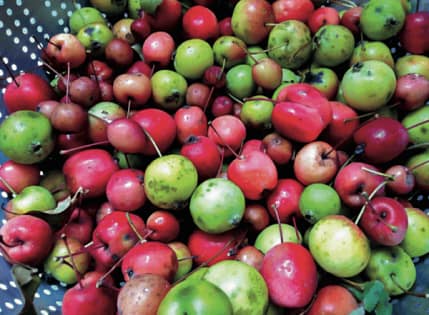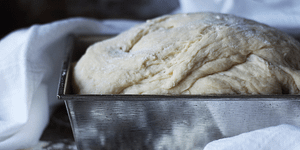The Surprisingly Sweet Secret of Crab Apples

Visiting an orchard to pick apples is enjoyable, but foraging for crab apples in your neighborhood is even more rewarding. These small fruits are easy to find, simple to store, and incredibly flavorful when used in meals.
Don’t believe us? Keep reading to learn more about the unsung heroes of the apple family.
The following excerpt is from The Fruit Forager’s Companion by Sara Bir. It has been adapted for the web.
Foraging for Crab Apples
Crab Apples (Malus spp.) are part of the Rosaceae family and can be grown throughout the US and Canada in zones 4–8.
If there’s one crab apple tree in your neighborhood, there are a hundred. Decorative and trustworthy, crab apple trees appear in front of houses and schools, or nestled in city parks. They don’t grow terribly tall, and are ideal for coexisting with humans in developed areas.
When & Where to Find Crab Apples
Sometimes I see them when I’m lost in thickets of trees on properties that have reverted to wild conditions, like mystery trees. Are they truly wild, or were they once in front of a house demolished long ago? Mulling it over is part of the fun.
For an amazing week or two in the spring, crab apples dazzle us with showy white or pink blossoms, and then set about making a fruit that goes generally unloved. There are hundreds of varieties of crab apples, and many of them are useless in culinary terms—tiny, hard as pellets, and unrelentingly tannic.
Crab Apples: Small But Mighty
But a resourceful person who finds a tree bearing crab apples that are larger and juicier will, come fall, never be bored. Hours and hours of picking and goofy kitchen experimentation await.
Crab apples are technically called such because of their size—small—and not their cultivar, since no two apple seeds are genetically alike. Think of them as their own fruit for culinary reasons, since you can’t use crab apples exactly as you would larger, more familiar apples.
Maintaining Crab Apple Trees
Unless it is diseased, a crab apple tree will merrily produce crab apples with zero maintenance, though well-timed pruning will keep the trees healthy and shapely. We had a dry summer last year, and while the rest of my favorite off-property fruit trees struggled to produce a fraction of their normal output, there were unlimited crab apples for the taking.
Why, then, are people not beating each other down to get to these things? Because they are a pain in the ass. A harvester can pick ten pecks of apples in the time it takes to collect one peck of crab apples. And obviously you can’t just eat them out of hand. Even desirable crab apples are sour. This sourness is presumably the root of their name, given that crabby connotes a difficult or grouchy person, though another theory is that it’s an alteration of Scots and northern English scrab. The term crab apple dates from the early fifteenth century.
Crab Apple Concerns
I am a sucker for underdogs, and so I adore crab apples, but with caveats. Their flesh, when cooked and pureed, is never silky like a good apple applesauce. It takes many crab apples to get much of an end yield, especially if you are coring and chopping their flesh to add to baked goods or chutneys.
Given the seemingly infinite variety of crab apples growing in yards and parks all over, how do you know which ones to target for harvesting? Simple: If you’re positive it’s a crab apple tree, pick one and bite into it. If you spit it out right away because it’s acrid and impossibly tannic, skip that tree. If it’s sour but also has actual apple flavor and a crisp, not over-firm flesh, it’s got potential. Dark red crab apples are pretty but usually more tannic.
Gathering Crab Apples
Always round up the time you expect you’ll need to gather any significant amount of crab apples. It can take ages to collect a pound. This is why the residents of the fancy condos downtown see me return again and again to the crab apple trees that grow between their condos and the riverfront bike path.
The trees are therapeutically perfect for zoning out under the dappled shade of their leaves at midday, and I like watching people ride by on the bike path. Getting a decent amount of crab apples is part of the point, but not all of the point.
If you are lucky a good tree may drop a lot of fruit in good condition all at once, but timing is of the essence in collecting it before it begins to rot.
Crab Apples: Nature’s Ornaments
As for the crab apple trees with fruit too unpalatable to use, I still find great pleasure in them. Many of their fruits cling to the branches all winter long, and some varieties stay red, like tiny cherries, months after the leaves have turned and fallen. They’re nature’s Christmas ornaments. In some conditions, these persistently present crab apples will slowly shrivel up as if they were air-cured, mellowing their bite and intensifying their sweetness. Take a nibble and if you like the flavor, try using them in boozy infusions.
My favorite pair of crab apple trees grow in front of a house not far from the city’s middle school, and the homeowner told me the many kids who pass by after school on their way home make use of the crab apples by pelting each other. Ah, the unbridled tomfoolery of the tween years. Throw them or pick them or simply look. Just don’t overlook crab apples.
Harvesting and Storing Crab Apples

Every time I gather crab apples, mosquitoes come to feast on my bare legs and arms, so dress appropriately or spray yourself with some noxious chemicals to increase your comfort.
Bring along a canvas bag or even a half-peck paper sack to hold the crab apples.
Refrigerate crab apples to extend their longevity, but I find they bruise easily and get spoiled spots within a day or two of storage.
Plan to process or cook them not too long after harvesting.
Coring crab apples is tedious as all get-out. I find the best way is to simply cut off all four sides with a paring knife, leaving behind the core. The yield is low, but it’s faster than pulling out a doll-sized apple corer.
Culinary Possibilities
Those with little patience for carefully chopping crab apples are best off with preparations that will ultimately be strained or forced through a sieve. Also, some crab apples (just like some apples) turn to mush after just a little simmering, while others hold their shape pretty well.
Think crab apple jelly, or toss a handful in with apples you’re cooking down into applesauce. In these cases, the only prep I do is to rinse them off and cut away any spoiled spots. Some recipes say to cut off the stem and blossom ends. I usually don’t, but I have found that roughly chopping the crab apples before cooking gives me more juice for my jelly.
Chef Andrew Whitcomb uses crab apples to make membrillo, swapping them for quince in the dense fruit paste. Another idea is to juice crab apples as you would for cider, and then ferment the juice for crab apple cider vinegar.
Recommended Reads
Recent Articles
Want to spice up your traditional bread recipes? This salt-rising bread recipe by fermentation expert Sandor Ellix Katz has all the simplicity, flavor, and uniqueness you’ve been searching for! The following is an excerpt from Sandor Katz’s Fermentation Journeys by Sandor Ellix Katz. It has been adapted for the web. What Is Salt-Rising Bread? Salt-rising…
Read MoreNothing says “spring” like a fresh, foraged meal! Savor the flavors of the season with this Milkweed Bud Pizza recipe.
Read MoreWhat’s so great about oyster mushrooms? First, you can add them to the list of foods that can be grown indoors! They are tasty, easy to grow, multiply fast, and they love a variety of substrates, making oyster mushrooms the premium choice. The following is an excerpt from Fresh Food from Small Spaces by R. J.…
Read More









